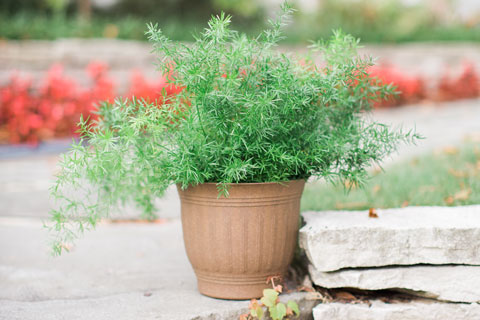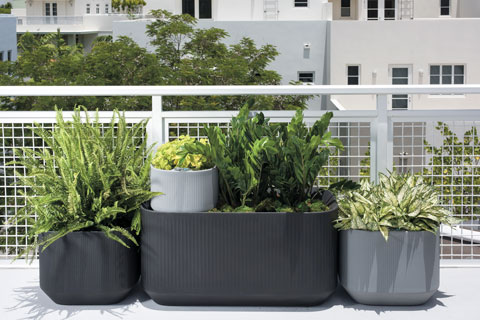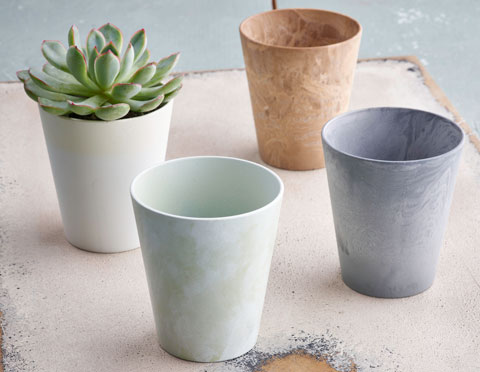2/1/2018
Staying on Point
Jennifer Polanz
Discerning trends when it comes to containers, pottery and window boxes is a rather tricky business. They vary from region to region, and even city to city, within this great expanse of a country. What we try to do here is find the commonalities among the entire country to show you what’s trending overall and then let you decide how best to serve your customers (of course).
With that said, there are some aspects of containers that are becoming universal throughout the country and here I’ll break them down by the four “dos” mentioned earlier: color, texture, shape and style. Let’s take on color first.
Once Again, Play It Safe
This is starting to become a common trend in 2018, particularly with color. I spoke with Ryan Mast, president of Bloem, a container company based in Grand Rapids, Michigan. They categorize colors into three groups, the mainstays (their dark gray, terracotta and off white), medium term colors (examples are deep, dark purple, deep blue) and more aggressive colors (the teals and brighter colors).
“We’re seeing very little change,” he notes. “There has to be a couple of colors to get that pop and ‘wow’ color to get their attention, and then they may end up buying something different.”
In other words, carry the mainstays, but intersperse the pops of color to garner attention to the display. He says both the mainstays and the bright colors continue to sell well across the country.
 Pictured: The new Lifestyle Colonnade pot from Bloem Living features an earthy look.
Pictured: The new Lifestyle Colonnade pot from Bloem Living features an earthy look.
Meanwhile, at Ceramo, Director of Product and Merchandising Alec Junge says he’s seeing a move toward a more muted palette with “organic-looking glazes” in natural colors and mossy greens versus the bright kiwi and limes greens and muted navy blues rather than electric blues. He’s also seeing a move toward black, white and gray colors.
“It seems to run cyclically in pottery,” he adds. “There’s a three- to four-year cycle of muted Earth tones then rebound back the other way toward things that are brighter and more vibrant again.”
Let’s Talk Textures
Textures go hand-in-hand with colors, so it’s tough to talk one without the other.
“We are seeing a trend of mixing colors and textures rather than using all the same. Matte and textured finishes on planters make upkeep easier than glossy finishes,” says Barbara Wise of Crescent Garden. “Using neutrals like the grays and applying colors like olive, midnight (dark blue) and bark (earthy brown) that have longevity.”
 Pictured: Mod Planters with the Trudrop watering system from Crescent Garden.
Pictured: Mod Planters with the Trudrop watering system from Crescent Garden.
Alec says, too, that in pottery, the texture is there more to accentuate the breaks where the colors mix together. Also, with texture comes design decoration, for which he’s seeing more demand.
When it comes to non-traditional pots, natural textures are paving the way around the country. One example is the oak and birch textured planters from Nature Innovations, which are blowmolded containers made to look like bark.
Trend Follows Trend
As we talked about in the December issue, the Millennials (and everyone else) love the houseplants. So, of course, that trend will spill over into all the ancillary products needed for houseplants, like pots. When we talk style, we’re seeing demand for smaller pots to accommodate all those pothos and snake plants being sold like hotcakes.
Tammy Burdzinski represents multiple lines of container products, including Novelty Manufacturing, which has seen great success with its line of smaller pots, like Cali in neutral colors, as well as the Mini Sprout Houses for terrariums and Mini Cache pots for indoor use.
 Pictured: Mini Cache Pots from Novelty Manufacturing.
Pictured: Mini Cache Pots from Novelty Manufacturing.
Alec from Ceramo also saw this during a visit to AmericasMart in Altanta this year. Houseplants and smaller containers were everywhere. In fact, he says they’re having a hard time keeping 13-in. and 14-in. diameter pots in stock, they’re moving so fast.
Coming Full Circle
Along with the houseplant trend, again, natural is emerging among those styles to pair with those houseplants. Kirsten Gallagher, who does public relations for Big Grass, says, “An increasingly popular product type among Big Grass grower and garden center customers are planters made from materials that match the natural habitats for orchids, bromeliads, ferns and other epiphytes.”
That’s why Big Grass expanded its Naturals Planter Collection to feature things like coconut coir, teakwood baskets and Acacia wood fern plaques.
Another aspect of style is how the pots are made and Tammy, who also reps Robert Allen, says the Glazed Ironstone pots were made with the customer’s needs in mind.
“Glazed IronStone planters are lightweight, strong and resilient. They have the ‘look’ of classic pottery with the strength of metal,” she notes. They also have a drain hole and plug, so they could be used indoors or out.
Before Buying
You probably already have your orders in for this year, but Alec provides some additional insight when buying pottery in the future.
“The way to capture eyeballs in pottery is to put out as wide array as possible within your pottery budget,” he says. “Put something that’s going to grab your customers’ eyeballs. The worst thing is to walk into Walmart and Home Depot and say, ‘this is what customers want to buy.’”
He recommends buying wide versus deep and give customers a whole lot of different looks.
“It’s always better to make a mistake going too broad than too deep,” he adds. “If you guess wrong on too deep, you’re stuck with a lot of something.” GP